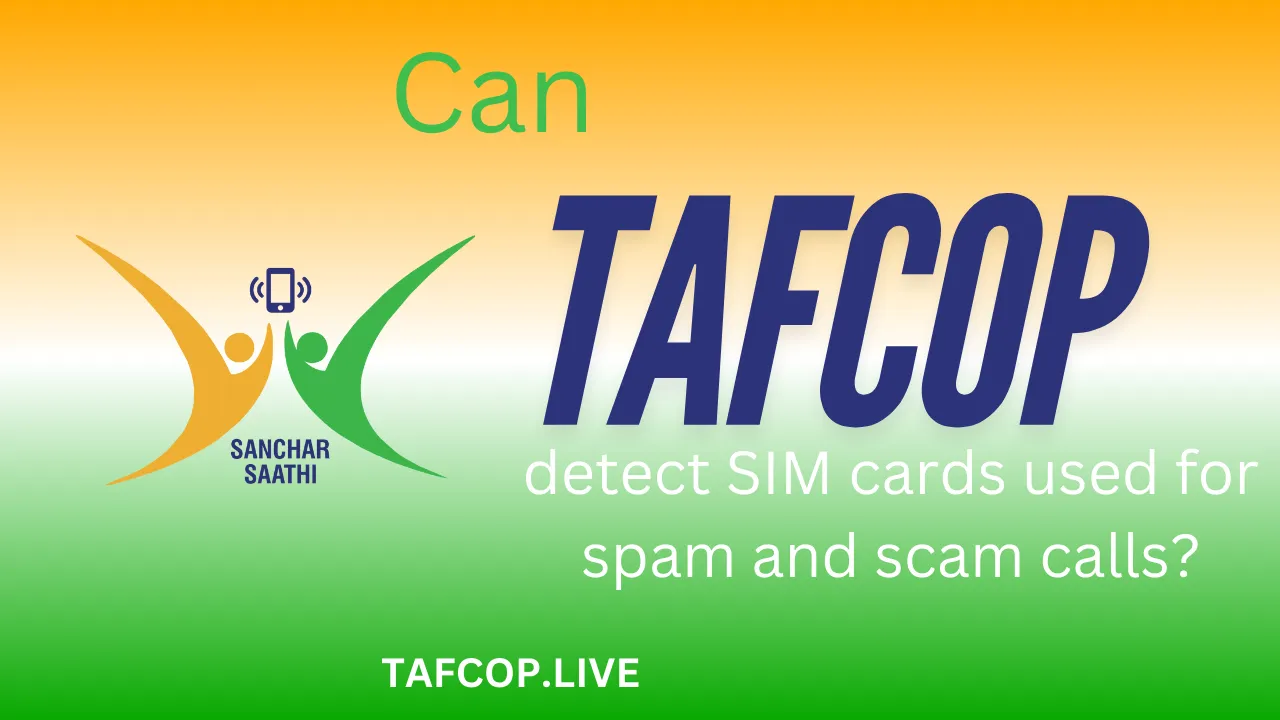In a world where spam and scam calls are as common as morning chai, the question on everyone’s mind is: Can TAFCOP detect SIM cards used for spam and scam calls? The answer is a resounding yes. TAFCOP, or the Telecom Analytics for Fraud Management and Consumer Protection, is a powerful tool designed to tackle the menace of fraudulent calls and messages. But how does it work, and what makes it so effective? Let’s dive in and explore.
Can TAFCOP detect SIM cards used for spam and scam calls?(Quick Answer)
Yes, TAFCOP can detect SIM cards used for spam and scam calls by analyzing call patterns, monitoring suspicious activities, and flagging numbers that exhibit fraudulent behavior. It empowers users to report and block such numbers, making it a vital tool in combating telecom fraud in India.
How Does TAFCOP Work to Detect Spam and Scam Calls?
TAFCOP operates like a digital watchdog for your phone. It uses advanced analytics to monitor call patterns and identify suspicious activities. For instance, if a SIM card is making an unusually high number of calls in a short period or sending bulk messages, TAFCOP flags it as potentially fraudulent.
The exact answer is: TAFCOP detects spam and scam calls by analyzing call data records (CDRs), tracking unusual behavior, and cross-referencing reported numbers with its database. This system is designed to catch fraudsters in the act, ensuring that your phone remains a safe space for communication.
For example, imagine a scammer using a SIM card to send fake lottery messages to hundreds of people. TAFCOP’s algorithms would notice the sudden spike in messages and flag the number for further investigation. This proactive approach helps curb spam before it reaches your inbox.
What Makes TAFCOP Effective in Combating Telecom Fraud?
TAFCOP’s effectiveness lies in its ability to combine technology with user participation. It doesn’t just rely on algorithms; it also encourages users to report suspicious numbers. This dual approach ensures that even the most cunning fraudsters can’t escape detection.
The exact answer is: TAFCOP is effective because it uses real-time data analysis, user-reported information, and collaboration with telecom operators to identify and block fraudulent SIM cards.
Think of it as a community-driven effort. When you report a spam number, you’re not just helping yourself—you’re contributing to a larger database that protects millions of users. It’s like a neighborhood watch, but for your phone.
Can TAFCOP Block Spam and Scam Calls Automatically?
While TAFCOP is incredibly smart, it doesn’t automatically block spam calls on its own. Instead, it provides you with the tools to take action. Once a number is flagged as suspicious, you can choose to block it or report it further.
The exact answer is: TAFCOP does not block spam calls automatically but empowers users to block and report fraudulent numbers through its platform.
For instance, if you receive a call from an unknown number offering a “too good to be true” deal, you can check it on TAFCOP. If the number has been reported by others, you’ll know to avoid it. This puts the power back in your hands.
How Can Indian Users Benefit from TAFCOP?
In India, where spam and scam calls are a daily nuisance, TAFCOP is a game-changer. It’s specifically designed to address the unique challenges faced by Indian telecom users, such as fake job offers, phishing calls, and fraudulent KYC updates.
The exact answer is: Indian users can benefit from TAFCOP by using it to report and block spam calls, verify suspicious numbers, and protect themselves from telecom fraud.
For example, if you receive a call claiming to be from your bank and asking for personal details, you can quickly check the number on TAFCOP. If it’s a known scam number, you’ll be alerted immediately. This simple step can save you from falling victim to fraud.
What Are the Limitations of TAFCOP?
While TAFCOP is a powerful tool, it’s not without its limitations. For one, it relies heavily on user reports, which means it’s only as effective as the people using it. Additionally, fraudsters are constantly evolving their tactics, making it a constant game of cat and mouse.
The exact answer is: TAFCOP’s limitations include its reliance on user reports, the evolving nature of fraud tactics, and the need for continuous updates to stay effective.
For instance, a scammer might use a new number that hasn’t been reported yet, making it harder for TAFCOP to detect. However, as more people use the platform and report suspicious activities, its effectiveness grows.
How to Use TAFCOP to Protect Yourself from Spam Calls?
Using TAFCOP is simple and straightforward. Here’s a step-by-step guide to get started:
- Visit the TAFCOP Website: Go to the official TAFCOP portal.
- Enter Your Mobile Number: Register your number to access the platform.
- Check Suspicious Numbers: Use the search feature to verify unknown numbers.
- Report Fraudulent Activity: If you encounter a spam call, report it immediately.
The exact answer is: To protect yourself from spam calls, use TAFCOP to verify unknown numbers, report suspicious activities, and block fraudulent SIM cards.
For example, if you receive a call from a number claiming to be a government official, you can quickly check it on TAFCOP. If it’s a scam, you’ll know to avoid it.
FAQs About TAFCOP and Spam Call Detection
Q1: Is TAFCOP free to use?
Yes, TAFCOP is completely free for Indian users. It’s a government initiative aimed at protecting consumers from telecom fraud.
Q2: Can TAFCOP detect international spam calls?
TAFCOP primarily focuses on Indian numbers, but it can flag international numbers if they’re reported by users.
Q3: How long does it take for TAFCOP to block a spam number?
The time varies depending on the number of reports and the severity of the activity. However, once a number is flagged, it’s added to the database for others to see.
Q4: Can I use TAFCOP on any mobile network?
Yes, TAFCOP works across all major Indian telecom operators, including Airtel, Jio, and Vodafone-Idea.
Conclusion
In a country like India, where spam and scam calls are a persistent problem, TAFCOP is a breath of fresh air. It’s not just a tool; it’s a movement towards safer and more secure communication. By leveraging advanced analytics and community participation, TAFCOP empowers users to take control of their telecom experience. So, the next time you receive a suspicious call, remember: TAFCOP has your back.
As the saying goes, “Prevention is better than cure.” With TAFCOP, you’re not just protecting yourself—you’re contributing to a safer digital ecosystem for everyone.

